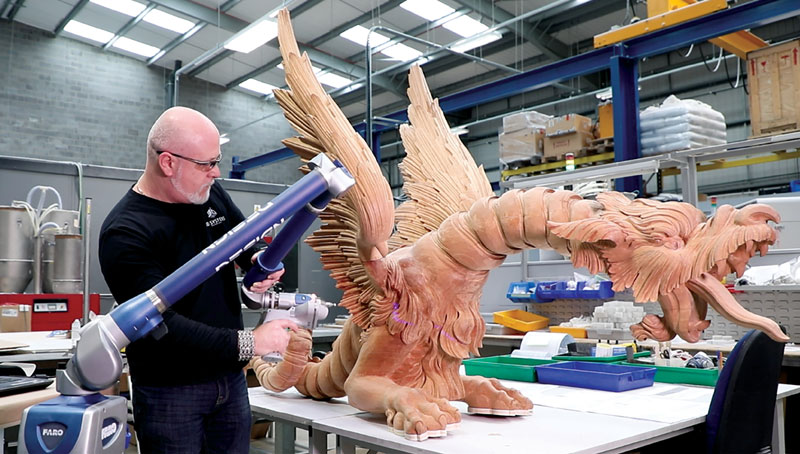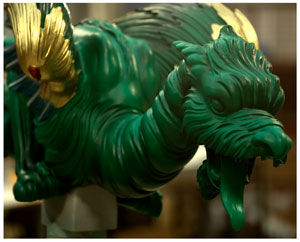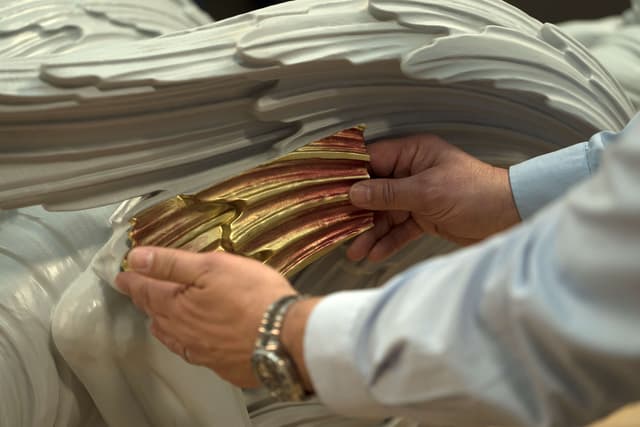3D systems are one of the critical systems in our lives; they help us restore creations that have lost one or more parts and help us repair historical monuments history.
1. 72 dragons
If a building has been around for 256 years, there is a chance it will not look as good as it initially did. Undoubtedly, the Great Pagoda in the middle of Kew Gardens was initially built for Princess Augusta in 1762. However, last year, the Historic Royal Palaces (HRP) implemented a restoration project for the 72 dragons that initially adorned the roofs.
At the time, the rumor circulated that the dragons, which were partly made of real gold, were sold as payment for royal gambling debts, but experts believe the dragons, primarily made of wood, had rotted.
It was important that the building be restored to its original beauty as much as possible, as in the years following the first unveiling, it drew crowds who came to admire its eye-catching and exotic structure. As HRP required a solution that would authentically replicate the dragons, the solution would also need to withstand weather conditions.
It was not just the aesthetics of the dragons that were part of the design stages; as HRP began to explore different methods, one task that became more challenging was the weight. The pagoda had not supported the weight of the dragons for two centuries. “One of the most challenging aspects of this project was to minimize the impact imposed by so many dragons on this grade one listed building,” said Craig Hatto, project director, Historic RoyalPalaces. The age of the structure was a concern in this respect, as it could have responded poorly to the sudden reintroduction of 80 full-weight, large-scale ornaments, so HRP started to look at lighter alternatives.

2. Perfect Solution: 3D Systems
A perfect restoration solution is needed to address the quality, weight, time, and cost concerns inherent to the project. Based on having the ability to provide the expertise, technology, quality, and scalability required to fulfill the project, 3D Systems won the bid for the project.
“We turned to 3D Systems to provide the rapid throughput, accurate details, and excellent finishing that was needed for this project,” said Hatto. “The engineering skill of 3D Systems’ team, the opportunity to light-weight the dragon statues, and the material longevity of SLS 3D printing were key considerations for this project.”
The 3D Systems On Demand Manufacturing team came up with a light-weight, durable, dragon-made scan-to-CAD workflow featuring Geomagic software, Selective Laser Sintering (SLS) 3D printing, and high-quality finishing. It is safe to say the project was far from a hands-off process and took the team many hours of front-end engineering and back-end finishing, which eventually led to them providing a high-quality full-service design.

With a reverse engineering workflow and a FARO Design ScanArm, the carved wooden dragons were scanned into a 3D design environment which enabled 3D Systems from here to address the concerns of HRP regarding weight and sustainability. Additionally, by scanning the data into CAD and hollowing the scan to a controlled thickness, 3D Systems could preserve both exterior details and, more importantly, the structural integrity.
However, the tough exteriors of the hand-cut masters became a little too complex for the hollowing geometry to be manufactured traditionally and needed additive manufacturing for production. So 3D Systems used a digital manufacturing workflow to seamlessly scale the dragons and eventually achieve a marginal size difference for levels two to ten of the pagoda. That resulted in 18 designs of the dragons were prepared and were made up of nine different sizes from 1150-1850mm in length, and to perfect things, there was a right-hand and a left-hand each version.
“In 3D printing, we are not limited by the need or time required to wait for tooling,” said Nick Lewis, general manager, 3D Systems On Demand Manufacturing. “The existence of digital 3D data gives us the freedom to produce parts rapidly, and with custom sizes.”
3D Systems were entirely in charge of the project until the end, so thinking ahead, the engineers planned another simple but almost essential feature in the dragons. They added a built-in mounting feature directly into the CAD files, constituting part of the dragons’ construction designs. 3D Systems worked on this part closely with Hockley & Dawson.
“The final dragons are essentially a perfect copy of the original but have been improved upon in a way that is invisible to the observer,” said Lewis. “We engineered internal elements for a secure mounting process but designed them in such a way as to be completely concealed so no nuts, bolts, or traces of construction will be visible.”
The dragons were printed on 3D Systems’ SLS machines in DuraFormPA, a durable polyamide 12 nylon material capable of producing a look and feel comparable to the original dragons. For all the complex parts with thin walls and snap-fit requirements, the resolution and properties of the DuraForm PA made it the best option.
In terms of the Kew dragons, these features suited both installation and the cosmetic functionality requirement. It Requirements of historic restoration. Finally, to finish off the dragons, 3D Systems’ skilled artisans hand-painted each 3D dragon individually; they started with the base layer as green all over.

Senior vice president and general manager, plastics and on-demand manufacturing at 3D Systems, Phil Schultz, commented: “We so often see 3D printing technology applied to innovations that when we get the chance to make history literally, it is quite exciting.”
He then added that in collaboration with HRP, 3D Systems could bring new technology to bear on a historical landmark, restore it to its former beauty, and helping to ensure its future for generations to come. He concluded: “It is a testament to the capabilities and expertise of our On-Demand Manufacturing team. Our full suite of durable materials, 3D printing technologies, reverse engineering software, and practical expertise allow us to create a custom solution no matter how unique the customer’s needs.”


















